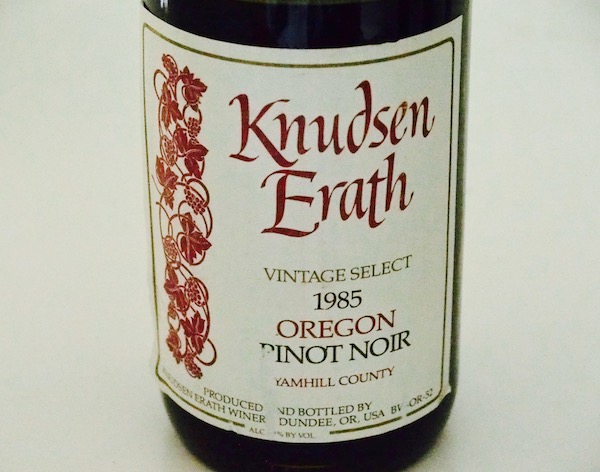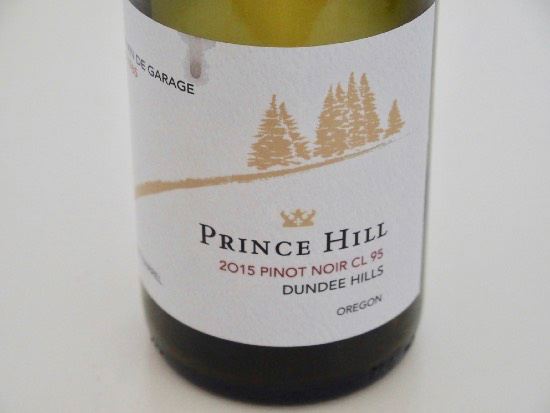Erath Pinot Noir Clone 95: A Promising Oregon Suitcase Selection
Dick Erath was one of “The Boys Up North” portrayed in the 1997 book by the same title written by Paul
Pintarich. This seminal book on the origins of the Oregon wine industry came out at a time when popular
opinion was transitioning from an impression that Oregon was rife with hippies making wine out of garages in
their backyards. Of course, nothing could have been farther from the truth. Sure, the early winemaking pioneers
often sported beards and had a laid back attitude that placed more emphasis on quality of life than material
possessions. But using any measuring stick you choose, by the 1990s Oregon Pinot Noir had already become
world class.
Erath had a varied background as an electronics engineer, a photographer, a jazz enthusiast, a racer of
Corvettes and a grower of Zinfandel and Ruby Cabernet grapes in Walnut Creek, California. According to
Pintarich, Earth had his wine epiphany when he drank an older bottle of Italian Malvasia Bianca.
In 1967, Erath enrolled in a two-week course at UC Davis, an experience that turned out to be life changing. He
met Andre Tchelistcheff and Louis Martini, and learned of vintners heading to Oregon to launch Oregon’s wine
industry. Richard Sommer, a UC Davis graduate who founded Hillcrest Winery in the Umpqua Valley and
planted the first Pinot Noir in Oregon, was also in the class. Sommers would encourage Erath to also move to
Oregon and later coined the phrase “the boys up north” in reference to the newer winemakers in the Willamette
Valley that included David Left, Dick Ponzi and Dick Erath.
A year later, in February 1968, Dick and first wife Kina Erath left the San Francisco Bay Area for Oregon’s
Willamette Valley, and purchased a 49-acre site in the Chehalem Mountains above Newberg. Earth called the
property Chehalem Mountain Vineyards and planted the first 4 acres to Pinot Noir, Riesling and
Gewürztraminer in 1969 using cuttings from the Wente family, Barney Fetzer and Richard Sommer. He also
experimented with a number of other cuttings, working with another Oregon pioneering vintner, Charles Coury,
who eventually became his partner in a nursery business, the Erath-Coury Nursery.
Erath quickly became friends with pioneering vintners Dick Ponzi, David Left, Bill Fuller and David Adelsheim.
In 1970, Erath, Lett and Coury lobbied with the Oregon State Legislature to stop the importation of wine grape
vines that were not virus free. This is ironic, since this article is about one of the rare instances of a suitcase
selection becoming planted successfully in Oregon (the others are the “Coury” clone and the “828” clone). To
Erath’s credit, he did not smuggle clone 95 into Oregon, but more about that later.
In 1975, Erath formed a partnership with C. Calvert “Cal” Knudsen, the Knudsen-Erath Winery, that lasted until
the 1980s. The Knudsen-Erath Winery was the first commercial winery in the Dundee Hills. Knudsen had
planted 30 acres of vines in 1972, the largest vineyard of the time that expanded to 60 acres by 1975. The pair
built a winery in the Dundee Hills and released many acclaimed wines including Pinot Noir, Chardonnay,
Riesling and sparkling wines, becoming one of the largest wineries in Oregon. In 1983, Erath planted the
34-acre Prince Hill Vineyard, 1.5 miles west of Dundee on the northern side of Worden Hill Road. This vineyard
became the centerpiece of the winery’s range of single-vineyard Pinot Noirs. It is planted to Pinot Noir clones
777, 667, 114, 113, 115, Pommard, Wädenswil, “Coury,” and “Erath clone 95.”

In 1987, Erath bought out Knudsen as the partnership amicably dissolved, and Knudsen went on to form an
Argyle Winery partnership with Australian Brian Croser. Erath kept the winery, buildings, and Prince Hill
Vineyard and formed Erath Vineyards. The transition was easy since Erath already was the winemaker and
grape grower for Knudsen-Erath.
By 1995, Dick Erath had brought on Rob Stuart as winemaker and Erath Vineyards & Winery was producing
35,000 cases of wine, primarily Pinot Noir, with lesser amounts of Pinot Gris, Pinot Blanc, Chardonnay and
Riesling. Gary Homer joined the winery as winemaker in 2002. In 2006, Erath Vineyards & Winery was sold to
Ste. Michelle Wine Estates. In 2012, the original Chehalem Mountains vineyard that Erath first planted in 1969
was sold to Judy Jordan, formerly of J Vineyards & Winery.
Erath, now 82, and fifty years since arriving in Oregon, has never lost his thirst for tinkering and innovation.
This brings us to “Erath clone 95” and a return to the mid 1970s when the story begins.
In 1975-1976, Erath had a friend visit Clos Vougeot in Burgundy, and while there, he grabbed cuttings that lay
on the ground, and smuggled them into the United States. He gave them to Erath, who promptly sent them to
Austin Goheen at the University of California at Davis Foundation Plant Services (FPS) to have the vines
cleaned up. The original material was given the designation FPS S1 and underwent heat treatment. Goheen
retired, and Erath heard nothing more about the fate of FPS S1 for many years. Erath was to find out later that
the original material had tested positive for virus in 1986 and underwent microshoot tip tissue culture disease
elimination treatment in 1997, whereby a new selection plus some backup vines from the same material were
created and the backup vines were renamed FPS 117.
In 1998, Erath received a surprising letter from FPS telling him the vines he had submitted had been
designated FPS 95 and “were ready.” In 2002, FPS sent Erath 16 mist propagated vines that had gone through
heat therapy. Using budwood from those vines, Erath then grafted ove 128 Pinot Blanc vines at
his Prince Hill Vineyard in the Dundee Hills. Now there are planted 4 acres on 3309 rootstock with another 7.5
acres going into fourth leaf, also on 3309 rootstock.
FPS 95 was later taken off the FPS listing because it tested positive for leaf roll virus in 2005, although Erath
had not seen that virus infestation at Prince Hill Vineyard. The backup vines from the same source material
were advanced to FPS Pinot noir 117, and are now available from FPS. The backup vines completed testing to
qualify for the Russell Ranch Foundation Vineyard in 2013 and were designated FPS Pinot noir 117.1.
Erath believes that FPS 117 (95) is similar to Pommard in appearance and wine character profile. However, it
has greater extract, higher skin tannin levels and appears resistant to botrytis. In 2013 in the Willamette Valley,
8 inches of rain fell during harvest, but no botrytis developed in Erath’s FPS 117 plantings. Erath believes that
this is the most distinctive feature of this selection since Pinot Noir clones in current use are botrytis-prone.
The nearly 40-acre Prince Hill Vineyard has slow-moving phylloxera infestation of unknown origin. In response,
Erath has planted 500 vines in sandy soil in a nursery at Grand Island, Oregon, near Dayton, where there is no
threat of phylloxera. A single barrel of clone 95 Pinot Noir was produced by Erath from these vines in 2016.
Erath sells clone 95 budwood to raise money for his Erath Family Foundation that advances viticultural and
enological science in Oregon. Through 2017, the “Erath clone” has been planted at Hyland Vineyard and
Holloran Vineyard. In 2018, plantings are planned for Brick House and maybe Beaux Frères. Word is getting
out and Erath expects to see a substantial increase in plantings in the coming years.
A bottle of 2012 “Clone 95” Pinot Noir (designated CL 95) and a bottle of 2012 “Coury” clone Pinot Noir (one
barrel produced of each) was reviewed previously: www.princeofpinot.com/article/1488/. Erath recently sent
me a bottle of his 2014, 2015 and 2016 “Clone 95” Pinot Noir that he vinified. These were one barrel wines
(once-filled French oak) not for commercial sale. Erath also related to me the history of clone 95.
The 2014 and 2015 bottling were based on an attempt to determine the limits of yield versus wine quality. The
2014 vintage was subject to no cluster thinning and leaves were striped only on east side. Yield was 6.7 tons
per acre (2.5 lbs per linear foot of Scott Henry trellis). The wine was co-fermented with 10% “Coury” clone, and
15% whole cluster. The 2015 vintage was cropped at about 4 tons per acre (1.5 lbs per linear foot of Scott
Henry trellis). Both of these crop levels at harvest would be considered high for Pinot Noir. The 2015 vintage
had 45% whole cluster in the ferment. The 2016 vintage was completely de-stemmed and co-fermented with
18% “Coury” clone from Prince Hill Vineyard. Erath believes that the “Coury” clone adds some “higher”
aromatics and thinks the combination of the two clones will be best.
2014 Prince Hill CL 95 Grand Vin De Garage Dundee Hills Pinot Noir
Light ruby red color with an orange
tinge in the glass. Shy, but pleasing aromas of red cherry, strawberry and grill rub spices. Light and delicate,
with slightly confected flavors of cherry, raspberry and spice, showing more fruit flavor than one would expect
from the light color but still a tad shallow. Silky in the mouth, finishing tangy with a citrus-coated cranberry
theme. The higher yields show in the lighter concentration of this wine.
Score: 90

2015 Prince Hill CL 95 Grand Vin De Garage Dundee Hills Pinot Noir
45% whole cluster fermented.
·
Moderately light garnet color in the glass. Enticing aromas of cherry, dark berry and sandalwood. The nose is
intoxicating. Mid weight flavors of black cherry and black raspberry with a welcome spice accent. The wine
offers well-structured tannins that are in balance, a deft touch of oak, and a pleasingly sappy cherry presence
woven through the finish. Reminded me of Pommard in character and even a Chambertin. This charming wine
continued to evolve in the bottle over a day’s time and became flat-out terrific.
Score: 95

2016 Prince Hill CL 95 Grand Vin De Garage Dundee Hills Pinot Noir
Harvest Brix 23.9º. pH 3.39, TA 0.61.
100% de-stemmed.
·
Moderate garnet color in the glass. Nicely perfumed with aromas of black cherry, black
raspberry, dried rose petal, balsam and earthy flora. Mid weight in style, with flavors of black cherry, black
raspberry, savory herbs, baking spices, vanilla and caramel. Impressive fruit purity and a sterling expression of
cherry fruit. Satiny in texture with suede tannins and a very long finish. More enticing when tasted later in the
day from an opened and re-corked bottle.
Score: 93
Laurent Montalieu of Hyland Estates released a 2015 Clone 95 Pinot Noir under the Prince Hill label. Erath
assigned the “Prince Hill” mark to him. The wine is exclusively clone 95 grapes that were planted, grown and
tended by Dick Erath. The wine commemorates Laurent’s and Dick’s collective 80 years of experience growing
and making wine in Oregon. Apparently, the wine is only available in the Hyland Estates tasting room.
The Duncan family, owners of California-based Silver Oak and Twomey, acquired Prince Hill Vineyard from
Erath for their Twomey brand in September 2017. The sale included the “Prince Hill Vineyard” brand, with
Twomey having use of the vineyard starting with the 2017 vintage. David Duncan plans to sell grapes from the
vineyard in the ensuing years while the vineyard undergoes some replanting with new clones.